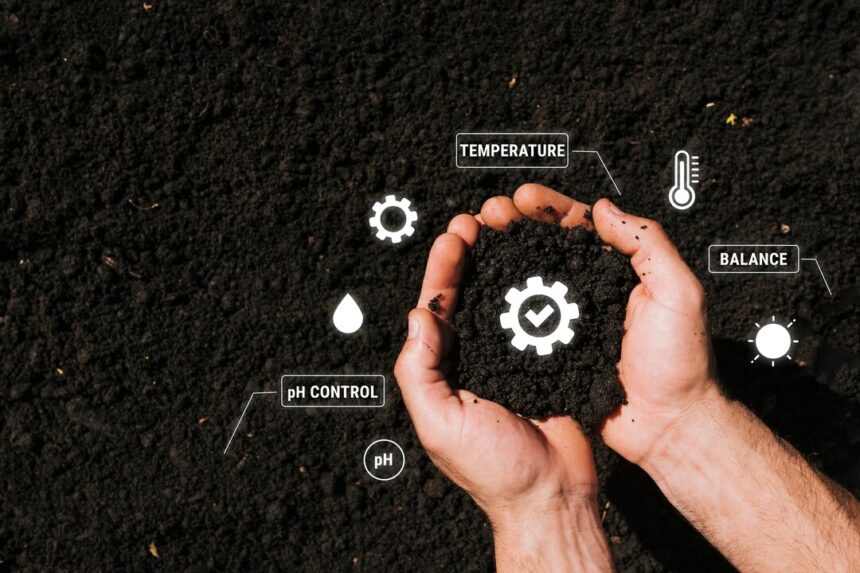Soil fertility is the backbone of successful farming, directly influencing crop quality and yield. For South African farmers, maintaining fertile soil is critical due to challenges like climate variability, water shortages, and soil degradation. Understanding soil fertility and using the right tools can help maximize productivity while ensuring long-term sustainability.
What is Soil Fertility?
Soil fertility refers to the soil’s ability to supply essential nutrients to plants in adequate amounts and proportions. Fertile soil supports healthy root development, optimizes water retention, and improves resistance to pests and diseases.
Key components of soil fertility include:
- Nutrients: Primary nutrients (nitrogen, phosphorus, and potassium) and micronutrients are essential for plant growth.
- Organic Matter: Decomposed plant and animal materials enhance soil structure and nutrient availability.
- pH Balance: A balanced pH allows plants to absorb nutrients efficiently.
- Microbial Activity: Beneficial microbes break down organic matter and improve nutrient uptake.
The Importance of Soil Fertility
- Improved Crop Yields
Fertile soil provides plants with the nutrients they need to grow strong and produce higher yields. Nutrient-deficient soil, on the other hand, leads to stunted growth and lower production. - Sustainable Farming
Healthy soil reduces the need for synthetic fertilizers, which can harm the environment. Fertile soil retains nutrients better, ensuring sustainable farming practices. - Water Efficiency
Fertile soil holds water more effectively, reducing water wastage and supporting crops during dry periods, a critical benefit in South Africa’s drought-prone areas. - Pest and Disease Resistance
Healthy plants grown in fertile soil are more resistant to pests and diseases, reducing the need for chemical interventions. - Economic Benefits
Investing in soil fertility reduces long-term input costs, improves yields, and increases profitability for farmers.
How to Use the Right Tools for Soil Fertility
Using the right tools is essential for managing and improving soil fertility. These tools help analyze, enrich, and maintain soil health effectively.
1. Soil Testing Kits
Soil testing kits are indispensable for assessing soil fertility. They measure nutrient levels, pH balance, and other critical factors.
- Use these kits to identify deficiencies in nutrients like nitrogen or phosphorus.
- Apply targeted fertilizers or organic matter based on test results to address specific needs.
2. Compost Spreaders
Compost enriches soil by adding organic matter and improving its structure. Compost spreaders distribute compost evenly across fields.
- Invest in a high-quality spreader to ensure efficient application, saving time and effort.
3. Plows and Tillers
Plows and tillers break up compacted soil, improving aeration and water infiltration.
- Use these tools to prepare the soil before planting and to incorporate organic matter into the soil.
4. Mulchers
Mulchers shred plant residues into smaller pieces, which decompose faster and add nutrients to the soil.
- Apply mulch to protect soil from erosion and retain moisture.
5. Irrigation Systems
Efficient irrigation systems like drip irrigation ensure that soil moisture is maintained without overwatering. This prevents nutrient leaching and supports plant growth.
- Use irrigation systems that deliver water directly to the root zone for better efficiency.
6. No-Till Seed Drills
No-till seed drills plant seeds without disturbing the soil, preserving its structure and reducing erosion.
- These tools are ideal for maintaining soil fertility in conservation farming systems.
7. Cover Crop Rollers
Cover crops improve soil fertility by adding organic matter and fixing nitrogen. Cover crop rollers flatten these crops, making them easier to decompose.
- Use this tool to manage cover crops effectively and enhance soil health.
8. Organic Fertilizer Spreaders
Organic fertilizers, such as manure or bone meal, are essential for boosting soil nutrients naturally. Fertilizer spreaders ensure even application.
- Calibrate the spreader to avoid over- or under-fertilizing specific areas.
9. Soil Aerators
Soil aerators create small holes in the soil, improving air and water circulation.
- Use this tool to prevent soil compaction, especially in high-traffic areas like grazing fields.
10. GPS-Guided Tractors
Modern technology like GPS-guided tractors ensures precise application of fertilizers and soil amendments.
- Use these tractors to save time and resources while enhancing soil management practices.
Maintaining Soil Fertility
- Regular Soil Testing
Conduct soil tests annually to monitor fertility levels and adjust your farming practices accordingly. - Practice Crop Rotation
Rotate crops to prevent nutrient depletion and reduce the risk of pests and diseases. - Add Organic Matter
Incorporate compost, manure, and crop residues into the soil to replenish nutrients and improve soil structure. - Prevent Erosion
Use contour farming, cover crops, and mulching to protect the soil from wind and water erosion. - Reduce Chemical Use
Minimize the use of synthetic fertilizers and pesticides, as they can harm soil health in the long run.
Soil fertility is the cornerstone of productive and sustainable farming. By understanding the importance of soil health and using the right tools, South African farmers can enhance yields, reduce costs, and contribute to environmental sustainability. Regularly test your soil, invest in efficient equipment, and adopt practices that promote soil health to ensure a thriving farm for years to come. Sustainable soil management not only benefits your crops but also secures the future of farming in South Africa.
Join 'Farmers Mag' WhatsApp Channel
Get the latest Farming news and tips delivered straight to your WhatsApp
CLICK HERE TO JOIN






